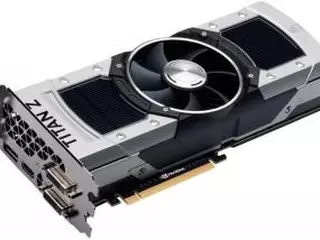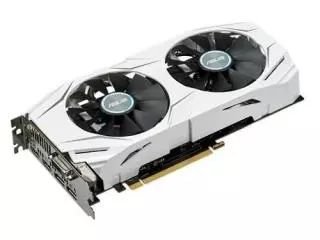GeForce GTX TITAN Z vs Radeon RX 480
When comparing GeForce GTX TITAN Z and Radeon RX 480, we look primarily at benchmarks and game tests. But it is not only about the numbers. Often you can find third-party models with higher clock speeds, better cooling, or a customizable RGB lighting. Not all of them will have all the features you need. Another thing to consider is the port selection. Most graphics cards have at least one DisplayPort and HDMI interface, but some monitors require DVI. Before you buy, check the TDP of the graphics card - this characteristic will help you estimate the consumption of the graphics card. You may even have to upgrade your PSU to meet its requirements. An important factor when choosing between GeForce GTX TITAN Z and Radeon RX 480 is the price. Does the additional cost justify the performance hit? Our comparison should help you make the right decision.
Main Specs
GeForce GTX TITAN Z
Radeon RX 480
Power consumption (TDP)
375 Watt
150 Watt
Interface
PCIe 3.0 x16
PCIe 3.0 x16
Supplementary power connectors
Two 8-pin
1x 6-pin
Memory type
GDDR5
GDDR5
Maximum RAM amount
12 GB
8 GB
Display Connectors
2x DVI, 1x HDMI, 1x DisplayPort
1x HDMI, 3x DisplayPort
Check Price
Check Price
GeForce GTX TITAN Z has 150% more power consumption, than Radeon RX 480.
Both video cards are using PCIe 3.0 x16 interface connection to a motherboard.
GeForce GTX TITAN Z has 4 GB more memory, than Radeon RX 480.
Both cards are used in Desktops.
GeForce GTX TITAN Z is build with Kepler architecture, and Radeon RX 480 - with Polaris.
Core clock speed of Radeon RX 480 is 415 MHz higher, than GeForce GTX TITAN Z.
GeForce GTX TITAN Z is manufactured by 28 nm process technology, and Radeon RX 480 - by 14 nm process technology.
Radeon RX 480 is 231 mm longer, than GeForce GTX TITAN Z.
Memory clock speed of Radeon RX 480 is 7993 MHz higher, than GeForce GTX TITAN Z.
Game benchmarks
Assassin's Creed Odyssey
Battlefield 5
Call of Duty: Warzone
Counter-Strike: Global Offensive
Cyberpunk 2077
Dota 2
Far Cry 5
Fortnite
Forza Horizon 4
Grand Theft Auto V
Metro Exodus
Minecraft
PLAYERUNKNOWN'S BATTLEGROUNDS
Red Dead Redemption 2
The Witcher 3: Wild Hunt
World of Tanks
high / 1080p
40−45
40−45
ultra / 1080p
27−30
27−30
QHD / 1440p
21−24
21−24
4K / 2160p
12−14
12−14
low / 720p
65−70
70−75
medium / 1080p
50−55
50−55
The average gaming FPS of Radeon RX 480 in Assassin's Creed Odyssey is 2% more, than GeForce GTX TITAN Z.
high / 1080p
65−70
65−70
ultra / 1080p
55−60
60−65
QHD / 1440p
40−45
45−50
4K / 2160p
21−24
21−24
low / 720p
110−120
120−130
medium / 1080p
70−75
75−80
The average gaming FPS of Radeon RX 480 in Battlefield 5 is 8% more, than GeForce GTX TITAN Z.
low / 768p
50−55
50−55
QHD / 1440p
12−14
24−27
The average gaming FPS of Radeon RX 480 in Call of Duty: Warzone is 21% more, than GeForce GTX TITAN Z.
low / 768p
250−260
250−260
medium / 768p
220−230
230−240
ultra / 1080p
200−210
200−210
QHD / 1440p
130−140
140−150
4K / 2160p
90−95
95−100
high / 768p
210−220
220−230
The average gaming FPS of Radeon RX 480 in Counter-Strike: Global Offensive is 3% more, than GeForce GTX TITAN Z.
low / 768p
60−65
60−65
medium / 1080p
55−60
55−60
GeForce GTX TITAN Z and Radeon RX 480 have the same average FPS in Cyberpunk 2077.
low / 768p
120−130
120−130
medium / 768p
110−120
110−120
ultra / 1080p
100−110
100−110
GeForce GTX TITAN Z and Radeon RX 480 have the same average FPS in Dota 2.
high / 1080p
50−55
55−60
ultra / 1080p
50−55
50−55
QHD / 1440p
30−35
35−40
4K / 2160p
18−20
18−20
low / 720p
90−95
90−95
medium / 1080p
55−60
55−60
The average gaming FPS of Radeon RX 480 in Far Cry 5 is 1% more, than GeForce GTX TITAN Z.
high / 1080p
70−75
75−80
ultra / 1080p
55−60
60−65
QHD / 1440p
30−35
35−40
4K / 2160p
27−30
27−30
low / 720p
190−200
200−210
medium / 1080p
120−130
130−140
The average gaming FPS of Radeon RX 480 in Fortnite is 7% more, than GeForce GTX TITAN Z.
high / 1080p
70−75
70−75
ultra / 1080p
50−55
55−60
QHD / 1440p
35−40
40−45
4K / 2160p
27−30
27−30
low / 720p
110−120
120−130
medium / 1080p
75−80
80−85
The average gaming FPS of Radeon RX 480 in Forza Horizon 4 is 7% more, than GeForce GTX TITAN Z.
low / 768p
150−160
150−160
medium / 768p
130−140
140−150
high / 1080p
80−85
85−90
ultra / 1080p
35−40
40−45
QHD / 1440p
27−30
30−35
The average gaming FPS of Radeon RX 480 in Grand Theft Auto V is 5% more, than GeForce GTX TITAN Z.
high / 1080p
30−33
30−35
ultra / 1080p
24−27
24−27
QHD / 1440p
18−20
20−22
4K / 2160p
10−12
10−12
low / 720p
75−80
80−85
medium / 1080p
40−45
40−45
The average gaming FPS of Radeon RX 480 in Metro Exodus is 2% more, than GeForce GTX TITAN Z.
low / 768p
130−140
130−140
medium / 1080p
130−140
130−140
GeForce GTX TITAN Z and Radeon RX 480 have the same average FPS in Minecraft.
ultra / 1080p
14−16
14−16
low / 720p
110−120
110−120
medium / 1080p
18−20
18−20
GeForce GTX TITAN Z and Radeon RX 480 have the same average FPS in PLAYERUNKNOWN'S BATTLEGROUNDS.
high / 1080p
27−30
30−35
ultra / 1080p
18−20
20−22
QHD / 1440p
14−16
14−16
4K / 2160p
9−10
10−11
low / 720p
75−80
80−85
medium / 1080p
40−45
45−50
The average gaming FPS of Radeon RX 480 in Red Dead Redemption 2 is 6% more, than GeForce GTX TITAN Z.
low / 768p
150−160
160−170
medium / 768p
100−105
100−110
high / 1080p
55−60
60−65
ultra / 1080p
30−35
30−35
4K / 2160p
18−20
21−24
The average gaming FPS of Radeon RX 480 in The Witcher 3: Wild Hunt is 5% more, than GeForce GTX TITAN Z.
low / 768p
90−95
90−95
medium / 768p
60−65
60−65
ultra / 1080p
55−60
60−65
The average gaming FPS of Radeon RX 480 in World of Tanks is 2% more, than GeForce GTX TITAN Z.
Full Specs
GeForce GTX TITAN Z
Radeon RX 480
Architecture
Kepler
Polaris
Code name
GK110B
Polaris 10 Ellesmere
Type
Desktop
Desktop
Release date
28 May 2014
29 June 2016
Pipelines
2880
2304
Core clock speed
705 MHz
1120 MHz
Boost Clock
876 MHz
1266 MHz
Transistor count
7,080 million
5,700 million
Manufacturing process technology
28 nm
14 nm
Texture fill rate
338 billion/sec
182.3
Floating-point performance
2x 5,046 gflops
5,834 gflops
Length
10.5" (26.7 cm)
241 mm
Memory bus width
768-bit (384-bit per GPU)
256 Bit
Memory clock speed
7.0 GB/s
8000 MHz
Memory bandwidth
672 GB/s
224 GB/s
Shared memory
-
DirectX
12 (11_1)
Shader Model
5.1
6.4
OpenGL
4.4
4.5
OpenCL
1.2
2.0
Vulkan
1.1.126
+
CUDA
+
FreeSync
+
CUDA cores
5760
Bus support
PCI Express 3.0
n/a
Height
4.376" (11.1 cm)
Multi monitor support
4 displays
HDMI
+
2.0
HDCP
+
Maximum VGA resolution
2048x1536
Audio input for HDMI
Internal
3D Gaming
+
3D Vision
+
3D Vision Live
+
Bitcoin / BTC (SHA256)
325 Mh/s
610 Mh/s
Eyefinity
+
HD3D
n/a
PowerTune
+
TrueAudio
n/a
ZeroCore
+
Mantle
n/a
Design
reference
Bridgeless CrossFire
+
DisplayPort support
1.4HDR
CrossFire
+
VCE
+
Ethereum / ETH (DaggerHashimoto)
27 Mh/s
Zcash / ZEC (Equihash)
270 Sol/s
Compute units
36
AppAcceleration
n/a
Blu Ray 3D
+
LiquidVR
+
TressFX
+
UVD
+
GCN generation
4th Gen
Enduro
n/a
FRTC
+
Check Price
Check Price

